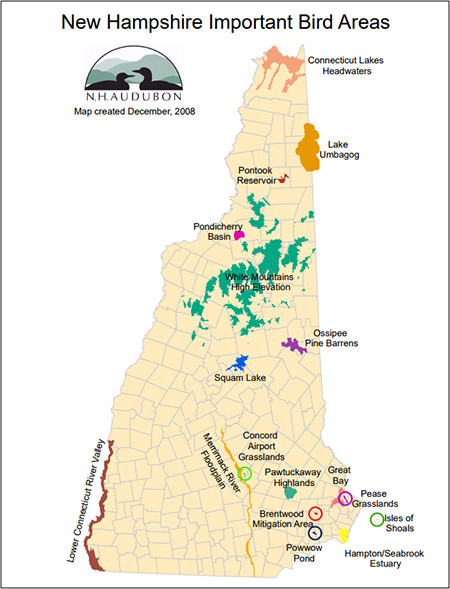About New Hampshire’s Important Bird Area (IBA) Program
For more detailed information about New Hampshire’s Important Bird Areas, select pages from the menu on the right.
New Hampshire Audubon, in collaboration with the NH Fish and Game Department, the NH Partners in Flight Committee, and UNH Cooperative Extension, conducts the Important Bird Area (IBA) program. The goal of the IBA program is to identify and conserve areas that are critical to one or more bird species for breeding, feeding, wintering, or migration.
For more information about the NH Important Bird Areas Program contact:
Pam Hunt, NH IBA Coordinator phunt@nhaudubon.org
NH Audubon
84 Silk Farm Road
Concord NH 03301
603-224-9909 x328
Current NH IBAs
Click here or the map to open a PDF version. Click any of the IBAs below to open a PDF description.
- Connecticut Lakes Headwaters
- Lake Umbagog
- Pontook Reservoir
- Pondicherry Basin
- White Mountains High Elevation
- Squam Lake
- Ossipee Pine Barrens
- Middle Connecticut River
- Merrimack River Floodplain
- Pawtuckaway Highlands
- Pease Grasslands
- Great Bay
- Powwow Pond
- Hampton-Seabrook Estuary
- Isles of Shoals
- Deer Hill Wildlife Management Area
About the IBA Program
The Important Bird Area Program is an international effort to identify areas that provide critical habitat to birds at some stage of their annual cycle, be it breeding, migration, or winter. The program began in Europe in 1981 and soon spread to Africa and Asia, with the United States initiating its program in 1996. Today, IBA programs are in place in over 100 countries and 46 states, including New Hampshire. Birdlife International (www.birdlife.net) is the parent organization of the IBA Program, and serves to oversee international coordination. In the United States the IBA Program is coordinated by the National Audubon Society (www.audubon.org).
Worldwide, the IBA program has helped conserve tens of millions of acres of habitat for rare or endemic birds, spurred new monitoring efforts, and even guided conservation legislation. The program has worked because birds are a highly visible and popular group of organisms, and thus better able to elicit public interest and support for conservation efforts. In the long run, many important “bird” areas will also aid in the conservation of more than just birds — they provide habitat for many other species of plants and animals, many of which are also of conservation concern.
With this in mind, the New Hampshire IBA Program evolved as an outgrowth of the NH Living Legacy Project, which seeks to identify ecologically significant areas in the state. The NH IBA program is a partnership of New Hampshire Audubon, the New Hampshire Fish and Game Department, and UNH Cooperative Extension, with additional input from the state’s Partners in Flight working group. The latter group developed the scientific criteria that are used to identify and evaluate potential IBAs in New Hampshire.
